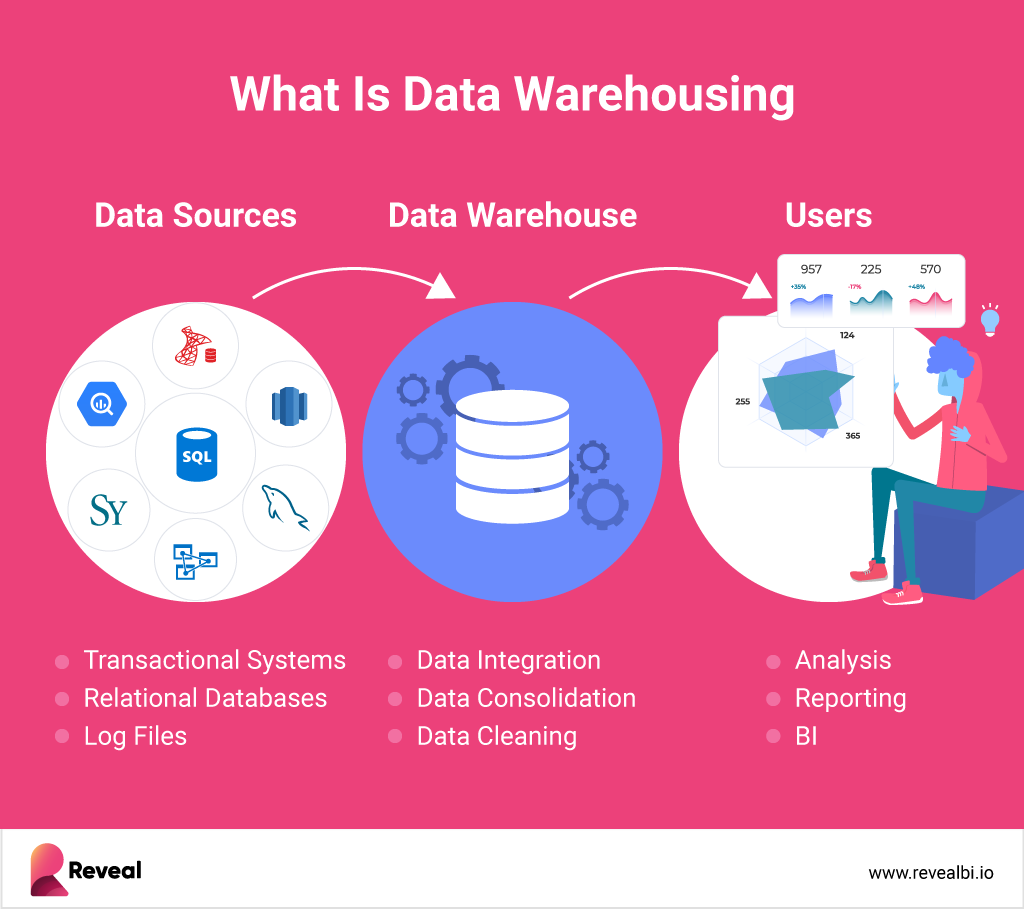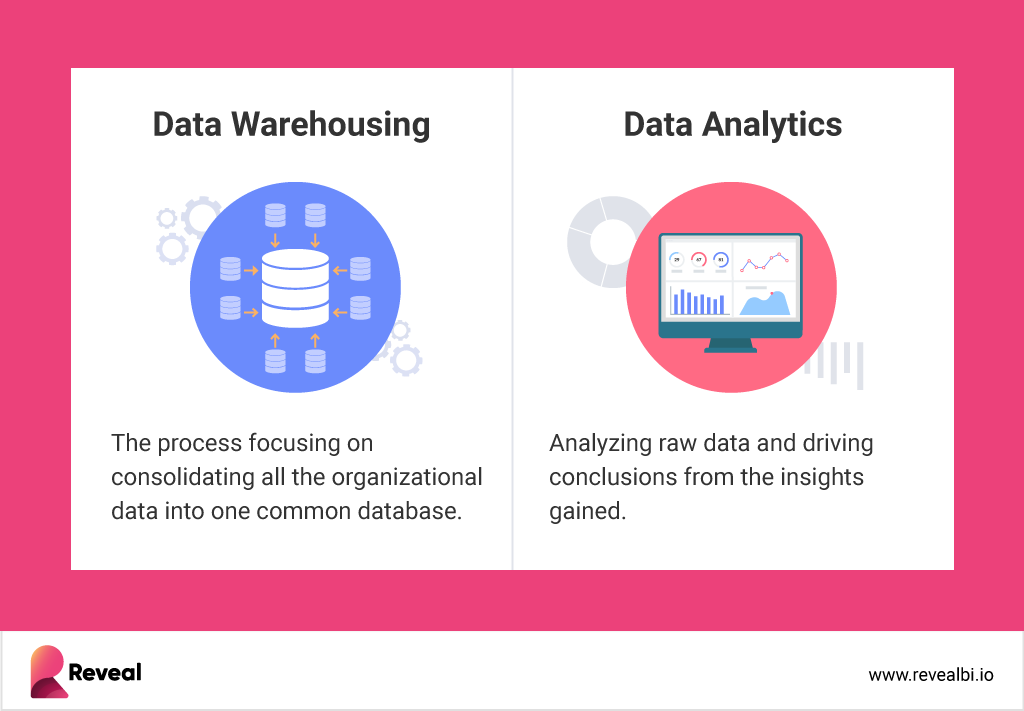
Scriptly Helps Pharmacies Identify Trends in Real Time with Reveal
Data warehousing supplies users with actionable insights and helps everyone within one organization make the right call on everything from marketing strategy and product development to human resources and budgeting.
Executive Summary:
In today’s data-driven world it is difficult to believe that for many organizations accessing and analyzing data still remains a distant goal.
Organizations that want to survive in the market need to keep up pace with new technologies and trends in the analytics space, so they can strengthen their competitive advantage and maximize ROI.
Embedded analytics and data warehousing tools and processes help organizations centralize all their data for easy access, analysis, and guide users, regardless of team or role, to make smarter business decisions in real time.
In this article, we’ll dive deeper into the topic of data warehousing and how data warehousing helps organizations to accelerate and improve business decisions and outcomes.
A data warehouse is a type of data management system that is designed to serve as a central repository of business information (not to be confused with a database, data lake, or data catalog) and to support business intelligence (BI) activities, especially data analytics. Data flows, typically on a regular basis, into a data warehouse from multiple sources such as transactional systems, relational databases, and application log files.
Typically, users access data in the data warehouse through analytics applications, SQL clients, or BI tools.

Data warehousing (DW) is a blend of processes and technologies which aids the construction and use of a data warehouse. The data warehousing processes are solely intended to perform queries and analysis and oftentimes contain historical data, making it easier for users to analyze data over a specific period of time, as well as apply machine learning algorithms and predictive analytics techniques to make predictions about the future. Data warehousing involves data integration, data consolidation, and data cleaning.
In other words, data warehousing is the process of transforming data into insights and making it available to users in a timely manner so they can make faster decisions.
The data warehousing process transforms relational data and other data sources into multidimensional schemas for the sole purpose of analyzing. During this transformation process, metadata is created to speed up queries and searches. On top of this layer lies a semantic layer that organizes and maps complex data into easy-to-understand business language like ‘’customer’’ or ‘’product’’, so analysts can quickly build comprehensive data analyses without the need to know database table names. Then, finally, an analyst’s layer lies on top of the semantic layer to give authorized users access to the data and help them visualize and interpret it.
Data warehousing and data analytics might seem to be the same thing, and although they are very similar in ways and are interrelated, both concepts are different processes. Data warehousing is the process focusing on consolidating all the organizational data into one common database, while data analytics is all about analyzing raw data and driving conclusions from the insights gained. The data analytics process can only begin after the data warehousing process is completed.

A well-established data warehousing process is the foundation of any successful analytics software. Its primary function is to power all analytics tools like dashboards and reports to better serve data users. Data warehousing supplies users with actionable insights and helps everyone within one organization make the right call on everything from marketing strategy and product development to human resources and budgeting.
Data warehousing comes with a plethora of benefits, but these are some of the best:
Speed up the decision-making process – data warehousing improves the speed at which data users can access different data sets and, as a result, makes it easier for everyone to derive actionable insights faster. By transforming data into purposeful information, business users can perform more precise and reliable analysis and create more useful reports with ease.
Ensure consistency – data warehouses are programmed to apply a uniform format to all collected data, which enables organizations to collect consistent and relevant data from numerous source systems. And since data from all departments and sources are standardized, every business user can produce results that are in line with all other departments. Standardized data also reduces the risk of errors in interrogation and improves overall accuracy.
Increases data security – a survey on data challenges by Forbes found that complications related to data cost businesses more than five million dollars every year. By using a data warehousing solution, leveraging advanced security techniques like a “slave read only” setup, which blocks malicious SQL code, and encrypted columns, you can keep all your data sources consolidated and protected. This significantly decreases the threats of data breaches, so your users can rest assured that their customer’s data is well managed and kept safe.
Historical intelligence – historical data typically cannot be stored in a transactional database or be used to generate reports from transactional systems, but data warehouses do store historical information making it easier for decision-makers to analyze different time periods and trends to make future predictions and drive continuous business improvements.
Save time – since users can quickly access crucial business information from numerous sources from the same platform, they won’t waste time retrieving that data but instead, focus on its value. What else saves business users time is that they can query the data themselves or with very little IT support, which is a win-win situation. Users don’t have to wait for ITs to generate their reports, and on the other hand, ITs are free from this task and can focus their expertise where it matters the most.
Generate higher ROI – organizations that have successfully implemented data warehousing processes generate more revenue while saving money at a higher rate than organizations that haven’t yet invested in an embedded analytics solution to help them better understand and use their data.
For starters, as discussed previously, efficient data warehousing can accelerate the load times for preparing and analyzing data. In the world of business intelligence and analytics, data warehousing functions as the backbone of data storage, providing and performing complex queries and comparing multiple data sets to inform everything from everyday operational decisions to organization-wide business expansion ones.
To facilitate this, embedded analytics/BI solutions encompass three overarching activities: data wrangling (typically facilitated by extract, transform, load [ETL] technologies), data storage, and data analytics. Data warehousing is the process that holds all this together and integrates, summarizes, and transforms data, making it easier to research and analyze.
They then provide an easy way to query the data to analyze it for trends, patterns, and insights, and visualize and share data through embedded dashboards and embedded reports.
When you get both data warehousing and analytics to work together seamlessly, you can unlock the full benefits of data analytics and accelerate business decisions. When you combine together, data warehousing and analytics tools make it possible to sync and store masses of structured and unstructured data that data users can run queries on to transform data on the fly and as a result make the best possible decision every single time.
Reveal is an end-to-end self-service embedded analytics solution that enables your teams and customers to drive data insights with embedded intelligence, accelerate time to market, and transform the user experience of your apps. Built with embedded in mind first, on today’s most modern architecture, Reveal’s powerful API removes the complexity of embedding analytics into your applications and allows you to seamlessly integrate your data from any SQL database or data warehouses, such as Microsoft Azure SQL Data Warehouse, Google BigQuery, Amazon Redshift, and more.
The embedded analytics platform by Reveal provides interactive data visualizations, white-label capabilities, advanced analytics, including machine learning and AI, drill-down, collaboration, sharing, and drag-and-drop dashboard creator experience. Users can easily access and create high-impact dashboards at any time and from any device.
You can learn more about Reveal by downloading the Reveal SDK, or by scheduling a quick product demo.
Back to Top